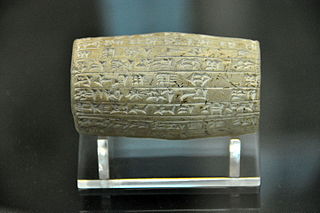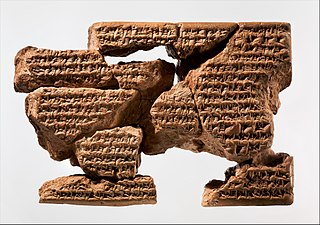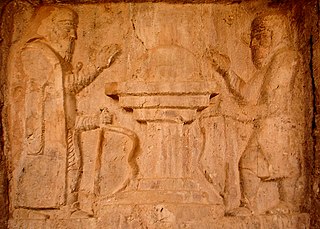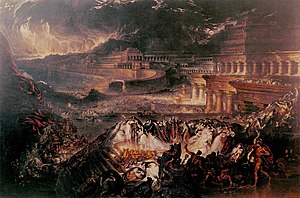
Chaldea was a country that existed between the late 10th or early 9th and mid-6th centuries BCE, after which the country and its people were absorbed and assimilated into Babylonia. Semitic-speaking, it was located in the marshy land of the far southeastern corner of Mesopotamia and briefly came to rule Babylon. The Hebrew Bible uses the term כשדים (Kaśdim) and this is translated as Chaldaeans in the Greek Old Testament, although there is some dispute as to whether Kasdim in fact means Chaldean or refers to the south Mesopotamian Kaldu.

The 7th century BC began the first day of 700 BC and ended the last day of 601 BC.

Babylonia was an ancient Akkadian-speaking state and cultural area based in central-southern Mesopotamia. A small Amorite-ruled state emerged in 1894 BCE, which contained the minor administrative town of Babylon. It was merely a small provincial town during the Akkadian Empire but greatly expanded during the reign of Hammurabi in the first half of the 18th century BCE and became a major capital city. During the reign of Hammurabi and afterwards, Babylonia was called "the country of Akkad", a deliberate archaism in reference to the previous glory of the Akkadian Empire.
This article concerns the period 619 BC – 610 BC.
The year 612 BC was a year of the pre-Julian Roman calendar. In the Roman Empire, it was known as year 142 Ab urbe condita. The denomination 612 BC for this year has been used since the early medieval period, when the Anno Domini calendar era became the prevalent method in Europe for naming years.

Nabopolassar was the founder and first king of the Neo-Babylonian Empire, ruling from his coronation as king of Babylon in 626 BC to his death in 605 BC. Though initially only aimed at restoring and securing the independence of Babylonia, Nabopolassar's uprising against the Neo-Assyrian Empire, which had ruled Babylonia for more than a century, eventually led to the complete destruction of the Assyrian Empire and the rise of the Neo-Babylonian Empire in its place.

Ashurbanipal, also spelled Assurbanipal, Asshurbanipal and Asurbanipal was the king of the Neo-Assyrian Empire from the death of his father Esarhaddon in 668 BC to his own death in 631 BC. The fourth king of the Sargonid dynasty, Ashurbanipal is generally remembered as the last great king of Assyria.

The Battle of Carchemish was fought about 605 BC between the armies of Egypt allied with the remnants of the army of the former Assyrian Empire against the armies of Babylonia, allied with the Medes, Persians, and Scythians. This battle is also mentioned in Ezekiel chapter 30 in the Bible.

Sinsharishkun or Sin-shar-ishkun was the penultimate king of Assyria, reigning from the death of his brother and predecessor Ashur-etil-ilani in 627 BC to his own death at the Fall of Nineveh in 612 BC.

Cyaxares was the third and most capable king of Media, according to Herodotus, with a far greater military reputation than his father Phraortes or grandfather Deioces. He was the first to divide his troops into separate sections of spearmen, archers, and horsemen.

The Neo-Assyrian Empire arose in the 10th century BC. Ashurnasirpal II is credited for utilizing sound strategy in his wars of conquest. While aiming to secure defensible frontiers, he would launch raids further inland against his opponents as a means of securing economic benefit, as he did when campaigning in the Levant. The result meant that the economic prosperity of the region would fuel the Assyrian war machine.

The Neo-Assyrian Empire was an Iron Age Mesopotamian empire, in existence between 911 and 609 BC, and became the largest empire of the world up until that time. The Assyrians perfected early techniques of imperial rule, many of which became standard in later empires. The Assyrians were the first to be armed with iron weapons, and their troops employed advanced, effective military tactics.
The Fall of Assur occurred when the first city and old capital of the Neo-Assyrian Empire fell to Median led forces. The sack of the city that followed destroyed the city to some degree; however it recovered during the Achaemenid Empire and appears to have been a semi or fully independent Assyrian state during the Parthian Empire before being conquered by the Sassanids in the late 3rd century AD. The city remained occupied by Assyrians until the massacres of Tamurlane in the 14th century AD.
The Fall of Harran refers to the siege and capture of the Assyrian city of Harran by the Median and Neo-Babylonian empires.

The Revolt of Babylon in 626 BC refers to the revolt of the general Nabopolassar and his war of independence until he successfully consolidated control of Babylonia in 620 BC, defeating the Neo-Assyrian Empire which had ruled Babylonia for more than a century. The revolt saw the formation of the Neo-Babylonian Empire and was one of the key factors contributing to the fall of Assyria; twenty years after the revolt had begun, Nabopolassar's army and that of his ally, Cyaxares of the Medes, had destroyed the Neo-Assyrian Empire.
Ashur-uballit II, also spelled Assur-uballit II and Ashuruballit II, was the final ruler of Assyria, ruling from his predecessor Sinsharishkun's death at the Fall of Nineveh in 612 BC to his own defeat at Harran in 609 BC. He was possibly the son of Sinsharishkun and likely the same person as a crown prince mentioned in inscriptions at the Assyrian capital of Nineveh in 626 and 623 BC.

The timeline of the Assyrian Empire can be broken down into three eras: Old Assyrian Empire, Middle Assyrian Empire, and Neo-Assyrian Empire.

The Sargonid dynasty was the final ruling dynasty of Assyria, ruling as kings of Assyria during the Neo-Assyrian Empire for just over a century from the ascent of Sargon II in 722 BC to the fall of Assyria in 609 BC. Although Assyria would ultimately fall during their rule, the Sargonid dynasty ruled the country during the apex of its power and Sargon II's three immediate successors Sennacherib, Esarhaddon and Ashurbanipal are generally regarded as three of the greatest Assyrian monarchs. Though the dynasty encompasses seven Assyrian kings, two vassal kings in Babylonia and numerous princes and princesses, the term "Sargonids" is sometimes used solely for Sennacherib, Esarhaddon and Ashurbanipal.

The Medo-Babylonian conquest of the Assyrian Empire was the last war fought by the Neo-Assyrian Empire between 626 and 609 BC. Succeeding his brother Ashur-etil-ilani, the new king of Assyria, Sinsharishkun, was immediately faced by the revolt of one of his brother's chief generals, Sin-shumu-lishir, who attempted to usurp the throne for himself. Though this threat was dealt with relatively quickly, the instability caused by the brief civil war may have made it possible for another official or general, Nabopolassar, to rise up and seize power in Babylonia. Sinsharishkun's inability to defeat Nabopolassar, despite repeated attempts over the course of several years, allowed Nabopolassar to consolidate power and form the Neo-Babylonian Empire, restoring Babylonian independence after more than a century of Assyrian rule. The Neo-Babylonian Empire, and the newly formed Median Empire under King Cyaxares, then invaded the Assyrian heartland. In 614, the Medes captured and sacked Assur, the ceremonial and religious heart of the Assyrian Empire, and in 612 their combined armies attacked and razed Nineveh, the Assyrian capital. Sinsharishkun's fate is unknown but it is assumed that he died in the defense of his capital. He was succeeded as king only by Ashur-uballit II, possibly his son, who rallied what remained of the Assyrian army at the city of Harran and, bolstered by an alliance with Egypt, ruled for three years, in a last attempt to resist the Medo-Babylonian invasion of his realm.
After the death of Assurbanipal in 631 BC, the Neo-Assyrian Empire entered a period of instability. This was the moment when the Babylonian ruler, Nabopolassar, led a revolt against Assyrian rule. After a few years of war, the Babylonians expelled the Assyrian forces from their territory.












